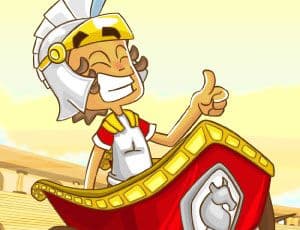Escola Games | Jogos Educativos
https://www.escolagames.com.br
Teacher's support sheet

Roman Numerals
In ancient Rome, gladiators were surrounded by glory and displayed their skills inside the Colosseum.
Today, you will go back in time and command a machine that shoots arrows. Your mission will be to collect all the coins scattered around the Colosseum.
Accumulate the coins, convert the total amount to Roman numerals and stay in command until you become a real Roman gladiator!

Teacher's tips
Level of education: Elementary School
Subject: Math
Age: 08 to 11 years old
This game is an excellent tool for fixing the content of Roman numerals, but it can also be used as an introduction to the content, associating it with the prior knowledge that the children already have. Working with Roman numerals and relating them to our numbering system helps children understand math and also the history of numbers! The game brings a playful and meaningful proposal of this content, relating it to ancient Rome, a time when these numbers were used. [FIM-DICA]
Learner outcomes
Know the Roman numeral system;
Understand the composition rules of these numbers;
Write and read Roman numerals;
Associate these numbers with current events, recognizing where they are found;
Fix knowledge acquired in the classroom;
Relate the composition and value of Roman numerals;
Work as a team in accordance with the guidelines given;
Teachers' goals
Offer a playful and meaningful didactic resource for working with Roman numerals;
Reinforce content worked in the classroom;
Introduce students to the Roman numeral system, its rules of composition, reading, writing and its use in everyday life;
Show a brief history of the Roman numeral system and its records;
Suggestions of approaches for the teacher
(Suggestion 1) Propose the game in pairs or individually. In pairs, children will have the opportunity to discuss, exchange ideas, knowledge, in addition to interacting.
During the plays, the pair will have 3 chances to get the writing of the Roman numerals right, if they still don't get it, the screen will show the correct writing. In order to ensure the retention of the content, it is important that the pairs have a sheet and pencil to record all the plays: record the number according to our numbering system and next to it, the same number represented in Roman numerals.
Use these records to prepare proposals in the classroom.
Elaborate other questions that relate contents worked on. For example:
- Put the result of operations in Roman numerals:
3 x 5 =
2 x 4 =
For students who already work with English vocabularies, the game offers the possibility of working with this other language, offering a more complex approach.
(Suggestion 2) Use roman numeral bingo. Bingo balls drawn will be natural numbers like traditional bingo and the table where the student must fill in must be in Roman numerals.
(Suggestion 3) Work with gold material.
(Suggestion 4) Create a board game: Take a card and make a board game containing the Roman numerals I to XX. You can paste Roman numerals I through VI into the data. Roll the dice and choose the numbers shown by them. This provides easy to read Roman numerals.
(Suggestion 5) Create Flash Cards: Take some pieces of cardboard and stick white papers on them. Write Roman numerals I through X on these paper covered pieces. You can make two sets of these cards.
Play a matching game or quiz by asking other players what the Roman numeral on the card means. You can also give the player two cards containing numbers to combine them and generate operations like addition and subtraction.
(Suggestion 6) Roman numerals using straws: Take three straws and cut them in half to get six smaller pieces. You can take these pieces one by one and arrange them in the form of Roman numerals. For example, take three smaller pieces made from straws. Place one of these first to introduce the Roman numeral 'I'. In the same way, you can ask the child to place the straw next to the previous one to familiarize himself with numbers I to III.
(Suggestion 7) Roman Numeral Calendar: Suitable for children in grades 3-4, teachers can give this activity as a homework project. Parents who are homeschooling their children at the kindergarten level can encourage wards to prepare this calendar under their guidance. The child can take a calendar month sheet and draw its pattern first. Then, instead of 1, 2, 3, etc., they can write the corresponding Roman numerals in the date blocks. This calendar helps in many ways. You can teach the concept of dates and days to the child and practically introduce Roman numerals, encouraging him to write.
(Suggestion 8) Roman Numeral Clock Making: This is a great activity that encourages kids to learn the concept of the hour and minute and build Roman numeral literacy in the process. You can engage the child further by holding a digital clock on the front and asking them to point out the corresponding time on this handcrafted Roman numeral clock. It makes an interesting time slot and can also work as classroom teaching aids.
(Suggestion 9) If there is a possibility of synchronizing the study of Roman numerals with the history of Rome, try to carry out some activity in common with the teacher of general history. Comics or films about "Asterix the Gaul" can be a playful introduction to working with Roman numerals.
More about the content
ROMAN NUMBERING SYSTEM:
The Romans used an interesting system to represent numbers. They used seven letters of the alphabet and assigned values to each of them:
I = 1
V = 5
X = 10
L = 50
C = 100
D = 500
M = 1000
Roman numerals are capital letters!
Rules:
- The system is divided into:
- Fundamental Numerals
I = 1 / X = 10 / C = 100 / M = 1000
- Secondary Numerals
V = 5 / L = 50 / D = 500
2nd) The fundamental numerals can be repeated up to three times. Never more than three!
Examples:
I, II, III (1,2,3)
X, XX, XXX (10,20,30)
C, CC, CCC (100,200,300)
M, MM, MMM (1000,2000,3000)
3rd) Secondary numerals can NEVER be repeated!
4th) When a fundamental numeral is to the left of the secondary one, you must subtract its value. When on the right, it should add.
Tips for reading Roman numerals:
- First identify the secondary number.
See the example:
XL – Note that it has 2 numerals (X and L).
I must see which one is the secondary.
In this case, it is the L, which is equal to 50.
It will be the starting point.
See which numeral is on your right to add to 50.
I notice you don't have any.
I see which numeral is on its left to subtract from 50.
I realize that it is X, which is equal to 10.
So I take 10 out of 50, which is 40.
Conclusion: XL = 40.
VII – In this case there is no value to subtract, as there is no numeral to the left of the secondary. But I have a value on the right, which must be added to V, which is my secondary.
II equals 2. So I must add II and V (2 and 5), which is 7.
Conclusion: VII = 7
Roman numerals are used to represent book chapters, dates of historical events, centuries, and names of kings and popes. Some watches use Roman numerals to represent the hours.
Check out how to write the numbers from 1 to 100 in Roman numerals:
1 – I
2 – II
3 – III
4 – IV
5 – V
6 – VI
7 – VII
8 – VIII
9 – IX
10 – X
11 – XI
12 – XII
13 – XIII
14 – XIV
15 – XV
16 – XVI
17th – 17th
18 – XVIII
19 – XIX
20 – XX
30 – XXX
40 – XL
50 – L
0 – LX
70 – LXX
80 – 80
90 – XC
100 – C
